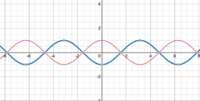You are using an out of date browser. It may not display this or other websites correctly.
You should upgrade or use an alternative browser.
You should upgrade or use an alternative browser.
Trig question in the form of a recurrence equation.
- Thread starter Sonal7
- Start date
Yes i noticed that. cos pi is always -1, but i am not sure about the value of n as its a variable. So if n were 2, then cos (pi + n pi/2) will be 1, so its I think - cos (n pi/2) will be 1. I guess it works.Note how the argument changed with the sign change.
I dont quite get the minus before the sin (n pi/2), as pi is 0, then n pi/2 will be the value of n pi/2 so this one seems wrong.
Last edited:
lev888
Elite Member
- Joined
- Jan 16, 2018
- Messages
- 2,993
Look at the graph of cos(x). Pick any value of x (let's call it A). Note the value of cos(A). Now look at cos(pi + A).Yes i noticed that. cos pi is always -1, but i am not sure about the value of n as its a variable. So if n were 2, then cos (pi + n pi/2) will be 1, so its I think - cos (n pi/2) will be 1. I guess it works.
I dont quite get the minus before the sin (n pi/2), as pi is 0, then n pi/2 will be the value of n pi/2 so this one seems wrong.




